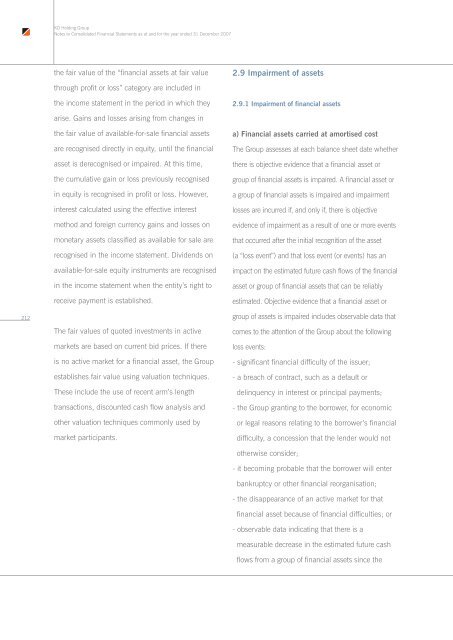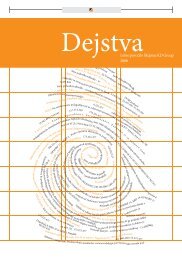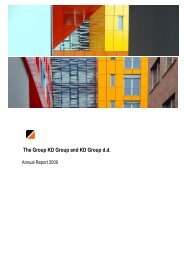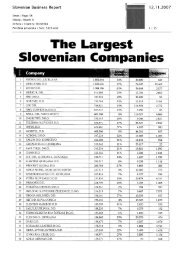We build business networks and relationships ... - skupina kd group
We build business networks and relationships ... - skupina kd group
We build business networks and relationships ... - skupina kd group
Create successful ePaper yourself
Turn your PDF publications into a flip-book with our unique Google optimized e-Paper software.
KD Holding Group<br />
Notes to Consolidated Financial Statements as at <strong>and</strong> for the year ended 31 December 2007<br />
the fair value of the “financial assets at fair value<br />
through profit or loss” category are included in<br />
the income statement in the period in which they<br />
2.9 Impairment of assets<br />
2.9.1 Impairment of financial assets<br />
arise. Gains <strong>and</strong> losses arising from changes in<br />
212<br />
the fair value of available-for-sale financial assets<br />
are recognised directly in equity, until the financial<br />
asset is derecognised or impaired. At this time,<br />
the cumulative gain or loss previously recognised<br />
in equity is recognised in profit or loss. However,<br />
interest calculated using the effective interest<br />
method <strong>and</strong> foreign currency gains <strong>and</strong> losses on<br />
monetary assets classified as available for sale are<br />
recognised in the income statement. Dividends on<br />
available-for-sale equity instruments are recognised<br />
in the income statement when the entity’s right to<br />
receive payment is established.<br />
The fair values of quoted investments in active<br />
markets are based on current bid prices. If there<br />
is no active market for a financial asset, the Group<br />
establishes fair value using valuation techniques.<br />
These include the use of recent arm’s length<br />
transactions, discounted cash flow analysis <strong>and</strong><br />
other valuation techniques commonly used by<br />
market participants.<br />
a) Financial assets carried at amortised cost<br />
The Group assesses at each balance sheet date whether<br />
there is objective evidence that a financial asset or<br />
<strong>group</strong> of financial assets is impaired. A financial asset or<br />
a <strong>group</strong> of financial assets is impaired <strong>and</strong> impairment<br />
losses are incurred if, <strong>and</strong> only if, there is objective<br />
evidence of impairment as a result of one or more events<br />
that occurred after the initial recognition of the asset<br />
(a “loss event”) <strong>and</strong> that loss event (or events) has an<br />
impact on the estimated future cash flows of the financial<br />
asset or <strong>group</strong> of financial assets that can be reliably<br />
estimated. Objective evidence that a financial asset or<br />
<strong>group</strong> of assets is impaired includes observable data that<br />
comes to the attention of the Group about the following<br />
loss events:<br />
- significant financial difficulty of the issuer;<br />
- a breach of contract, such as a default or<br />
delinquency in interest or principal payments;<br />
- the Group granting to the borrower, for economic<br />
or legal reasons relating to the borrower’s financial<br />
difficulty, a concession that the lender would not<br />
otherwise consider;<br />
- it becoming probable that the borrower will enter<br />
bankruptcy or other financial reorganisation;<br />
- the disappearance of an active market for that<br />
financial asset because of financial difficulties; or<br />
- observable data indicating that there is a<br />
measurable decrease in the estimated future cash<br />
flows from a <strong>group</strong> of financial assets since the







